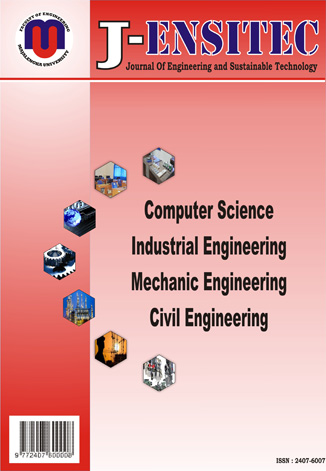ANALISIS ENDAPAN SEDIMEN DASAR BENDUNG KAMUN TERHADAP TINGGI MERCU DAN KEHILANGAN DEBIT AIR SALURAN INDUK CILUTUNG BARAT KABUPATEN MAJALENGKA
DOI:
https://doi.org/10.31949/jensitec.v10i02.9618Abstract
Kamun Dam is a permanent weir with its water intake in the Cilutung River Basin (DAS). One major factor affecting water reduction at the weir is sediment settling at the upstream base. Effective and efficient management is crucial for irrigation water and networks to maximize benefits. Water loss from primary to secondary and tertiary channels negatively impacts irrigation system performance. The water flow through weirs and structures with varying discharges influences the water surface profile and its characteristics.This research aimed to determine the water level, total sediment transport capacity, water discharge loss in the West Cilutung main channel, and the water surface profile shape. The data comprised primary data from field investigations and secondary data, including average discharge data from 2008-2017.Water level analysis was performed using hydraulic formulas and the Trial and Error method. The highest water level recorded was 0.74 m in April, and the lowest was 0.22 m in August. Sediment transport analysis, using the Meyer-Peter Muller method, estimated that it would take approximately 13 years to fill the upstream of Kamun Dam with 1,436,470.04 m³ of sediment, without dredging, given a river width of 74.15 m and height of 3 m. Water discharge loss analysis, using the inflow and outflow method, showed Qrenc results from BLK.1-BLB.1 at 0.06 m³/sec and Qactual at 0.27 m³/sec. The water surface profile analysis, using the graphical integration method, yielded Qrenc results for profile I f(y) = 4786 and Qactual results for profile I f(y) = 789
Keywords:
Kamun Dam, Sedimentation, Water Loss, Water Level ProfileDownloads
References
Akbar, M. (2023). Analisis Sedimentasi Pada Bendung Awo Kabupaten Wajo, Jurnal Karajata Engineering, Teknik Sipil Universitas Muhammadiyah Parepare, Parepare.
Andi Yahya. (2013). Studi Experimental Angkutan Sedimen Dasar pada Saluran Terbuka, Jurnal Teknik Sipil Universitas Hasanuddin. Makassar.
Asdak, C. (2014). Hidrolgidan Pengolahan Daerah Aliran Sungai, Gajah Mada University Press. Yogyakarta.
Direktorat Jendral Pengairan, Departemen Pekerjaan Umum, (1986). Standar Perencanaan Irigasi: Kriteria Perencanaan Jaringan Irigasi (KP-01), Jakarta.
Hambali, R. (2016). Studi Karakteristik Sedimen dan Laju Sedimentasi Sungai Daeng-Kabupaten Bangka Barat. Jurnal Fropil Vol 4 Nomor 2, 173.
Hermawan, A., & Afiato, E. N. (2021). Analisis Angkutan Sedimen Dasar (Bed Load) Pada Saluran Irigasi Mataram Yogyakarta, Teknik Sipil Institut Teknologi Nasional Yogyakarta, Yogyakarta.
Karim, T Nenny. (2010) Bahan Kuliah Angkutan Sedimen, Teknik Sipil Unismuh Makassar, Makassar.
Mangore, V. R., Wuisan, E. M., Kawet, L., & Tangkudung, H. (2013). Perencanaan bendung untuk daerah irigasi sulu. Jurnal Sipil Statik, Universitas Sam Ratulangi. 1(7).
Priyantoro, (1991). Studi Eksperimental Aliran laminar pada Saluran Terbuka, Tesis Teknik Sipil UKRIM, Yogyakarta.
Puslitbang SDA, (2010). Pedoman Pengelolaan Dan Pengukuran Sedimen, Kementerian Pekerjaan Umum, Bandung.
Siswanto, R., Kartini, K., & Herawati, H. (2021). Studi Karakteristik Dan Laju Angkutan Sedimen Parit Langgar Desa Wajok Hilir Kecamatan Siantan Kabupaten Mempawah. Jurnal Teknik Sipil Universitas Tanjungpura.
Soewarno, (2013). Hidrometri dan Aplikasi Teknosabo Dalam Pengelolaan Sumber Daya Air. Graha Ilmu Hidrologi. Yogyakarta.
Sood, M. F. (2018). Analisa Angkutan Sedimen Sungai Jawi Kecamatan Sungai Kakap Kabupaten Kubu Raya. 9.
Susianty, E. (2015). Studi Sedimentasi di Bendung Namu Sira-Sira dan Kaitannya terhadap Tinggi Mercu Bendung, (Doctoral dissertation, Universitas Sumatera Utara).
Triatmodjo, Bambang, (2008). Hidraulika II, Beta Offset, Yogyakarta. Maedjikoen, Pragnyono, Transportasi Sedimen, UGM.
Van Rijn, L. C. (1984). Sediment transport: Part I: Bed load Sediment Transport: Part II: Suspended Sediment Transport. Journal of Hydraulics Engineering, ASCE, Vol. 110, 10-11
Published
How to Cite
Issue
Section
License
Copyright (c) 2024 Erni Sari Lumban Toruan, Arief Rijaluddin, Asep Dian Heryadiana, Yoyo Sunarya

This work is licensed under a Creative Commons Attribution-ShareAlike 4.0 International License.
An author who publishes in the J-ENSITEC (Journal of Engineering and Sustainable Technology) agrees to the following terms:
- Author retains the copyright and grants the journal the right of first publication of the work simultaneously licensed under the Creative Commons Attribution-ShareAlike 4.0 License that allows others to share the work with an acknowledgment of the work's authorship and initial publication in this journal
- The author is able to enter into separate, additional contractual arrangements for the non-exclusive distribution of the journal's published version of the work (e.g., post it to an institutional repository or publish it in a book) with the acknowledgment of its initial publication in this journal.
- The author is permitted and encouraged to post his/her work online (e.g., in institutional repositories or on their website) prior to and during the submission process, as it can lead to productive exchanges, as well as earlier and greater citation of the published work







